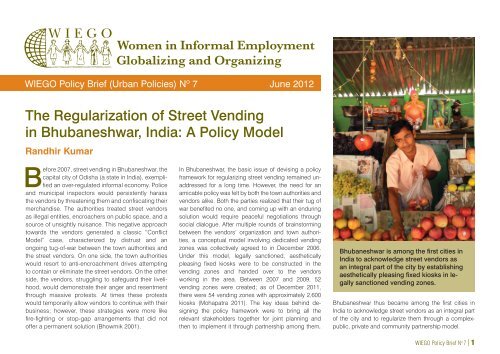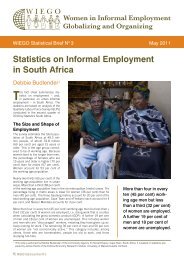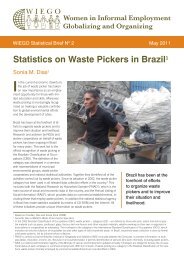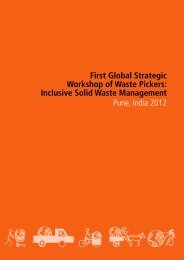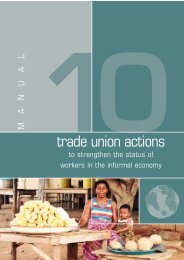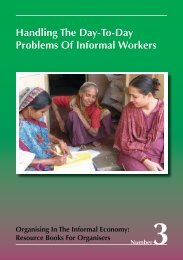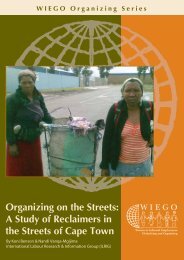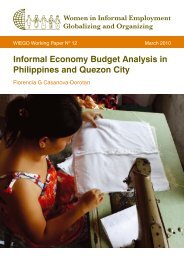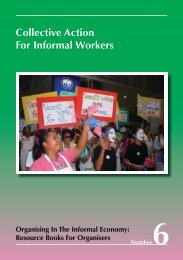The Regularization of Street Vending in ... - Inclusive Cities
The Regularization of Street Vending in ... - Inclusive Cities
The Regularization of Street Vending in ... - Inclusive Cities
Create successful ePaper yourself
Turn your PDF publications into a flip-book with our unique Google optimized e-Paper software.
WIEGO Policy Brief (Urban Policies) N o 7 June 2012<br />
<strong>The</strong> <strong>Regularization</strong> <strong>of</strong> <strong>Street</strong> <strong>Vend<strong>in</strong>g</strong><br />
<strong>in</strong> Bhubaneshwar, India: A Policy Model<br />
Randhir Kumar<br />
Before 2007, street vend<strong>in</strong>g <strong>in</strong> Bhubaneshwar, the<br />
capital city <strong>of</strong> Odisha (a state <strong>in</strong> India), exemplified<br />
an over-regulated <strong>in</strong>formal economy. Police<br />
and municipal <strong>in</strong>spectors would persistently harass<br />
the vendors by threaten<strong>in</strong>g them and confiscat<strong>in</strong>g their<br />
merchandise. <strong>The</strong> authorities treated street vendors<br />
as illegal entities, encroachers on public space, and a<br />
source <strong>of</strong> unsightly nuisance. This negative approach<br />
towards the vendors generated a classic “Conflict<br />
Model” case, characterized by distrust and an<br />
ongo<strong>in</strong>g tug-<strong>of</strong>-war between the town authorities and<br />
the street vendors. On one side, the town authorities<br />
would resort to anti-encroachment drives attempt<strong>in</strong>g<br />
to conta<strong>in</strong> or elim<strong>in</strong>ate the street vendors. On the other<br />
side, the vendors, struggl<strong>in</strong>g to safeguard their livelihood,<br />
would demonstrate their anger and resentment<br />
through massive protests. At times these protests<br />
would temporarily allow vendors to cont<strong>in</strong>ue with their<br />
bus<strong>in</strong>ess; however, these strategies were more like<br />
fire-fight<strong>in</strong>g or stop-gap arrangements that did not<br />
<strong>of</strong>fer a permanent solution (Bhowmik 2001).<br />
In Bhubaneshwar, the basic issue <strong>of</strong> devis<strong>in</strong>g a policy<br />
framework for regulariz<strong>in</strong>g street vend<strong>in</strong>g rema<strong>in</strong>ed unaddressed<br />
for a long time. However, the need for an<br />
amicable policy was felt by both the town authorities and<br />
vendors alike. Both the parties realized that their tug <strong>of</strong><br />
war benefited no one, and com<strong>in</strong>g up with an endur<strong>in</strong>g<br />
solution would require peaceful negotiations through<br />
social dialogue. After multiple rounds <strong>of</strong> bra<strong>in</strong>storm<strong>in</strong>g<br />
between the vendors’ organization and town authorities,<br />
a conceptual model <strong>in</strong>volv<strong>in</strong>g dedicated vend<strong>in</strong>g<br />
zones was collectively agreed to <strong>in</strong> December 2006.<br />
Under this model, legally sanctioned, aesthetically<br />
pleas<strong>in</strong>g fixed kiosks were to be constructed <strong>in</strong> the<br />
vend<strong>in</strong>g zones and handed over to the vendors<br />
work<strong>in</strong>g <strong>in</strong> the area. Between 2007 and 2009, 52<br />
vend<strong>in</strong>g zones were created; as <strong>of</strong> December 2011,<br />
there were 54 vend<strong>in</strong>g zones with approximately 2,600<br />
kiosks (Mohapatra 2011). <strong>The</strong> key ideas beh<strong>in</strong>d design<strong>in</strong>g<br />
the policy framework were to br<strong>in</strong>g all the<br />
relevant stakeholders together for jo<strong>in</strong>t plann<strong>in</strong>g and<br />
then to implement it through partnership among them.<br />
Bhubaneshwar is among the first cities <strong>in</strong><br />
India to acknowledge street vendors as<br />
an <strong>in</strong>tegral part <strong>of</strong> the city by establish<strong>in</strong>g<br />
aesthetically pleas<strong>in</strong>g fixed kiosks <strong>in</strong> legally<br />
sanctioned vend<strong>in</strong>g zones.<br />
Bhubaneshwar thus became among the first cities <strong>in</strong><br />
India to acknowledge street vendors as an <strong>in</strong>tegral part<br />
<strong>of</strong> the city and to regularize them through a complexpublic,<br />
private and community partnership model.<br />
WIEGO Policy Brief N o 7 I 1
<strong>The</strong> Conceptual Design: A<br />
Public-Private-Community<br />
Partnership Model<br />
<strong>in</strong>vited to take part <strong>in</strong> plann<strong>in</strong>g were representatives from<br />
Bhubaneshwar Development Authority, Public Works<br />
Department, National Highway Authority <strong>of</strong> India, Orissa<br />
Industrial Infrastructure Development Corporation, Forest<br />
Department, local Police and the Regional Transport Office.<br />
<strong>The</strong> process <strong>of</strong> conceptualiz<strong>in</strong>g and design<strong>in</strong>g the<br />
vend<strong>in</strong>g zone model was <strong>in</strong>itiated through the partnership<br />
between town authorities (public) and street<br />
vendors (community). While prime actors <strong>in</strong> the public<br />
doma<strong>in</strong> were the Bhubaneshwar Municipal Corporation<br />
and General Adm<strong>in</strong>istration (GA Department, Government<br />
<strong>of</strong> Odisha), the street vendors’ community<br />
was represented by a body <strong>of</strong> eight elected members<br />
from the National Association <strong>of</strong> <strong>Street</strong> Vendors <strong>of</strong><br />
India (NASVI) and its associates, AORVA and NKUBM.<br />
<strong>The</strong> eight elected members came from the Market Committee,<br />
a body composed <strong>of</strong> general secretaries <strong>of</strong> various<br />
vendor markets <strong>in</strong> Bhubaneshwar. Other stakeholders<br />
Figure 1: <strong>The</strong> Public, Private and Community Partnership Model for the Creation <strong>of</strong> <strong>Vend<strong>in</strong>g</strong> Zones<br />
Town<br />
Authorities<br />
Collaboration<br />
Collaboration<br />
<strong>Vend<strong>in</strong>g</strong><br />
Zones<br />
Other<br />
Partners<br />
Representatives from all the stakeholders together<br />
constituted a body called the City Management Group<br />
(CMG). Several rounds <strong>of</strong> meet<strong>in</strong>gs were organized<br />
<strong>in</strong> which the models proposed were debated and<br />
improved upon. Dur<strong>in</strong>g the meet<strong>in</strong>gs, the stakeholders<br />
also came up with a mutually agreed-upon action plan<br />
detail<strong>in</strong>g how to proceed with the creation and dedication<br />
<strong>of</strong> vend<strong>in</strong>g zones. <strong>The</strong> members <strong>of</strong> CMG who<br />
missed the scheduled meet<strong>in</strong>gs were later apprised<br />
about the proceed<strong>in</strong>gs and the consensus built dur<strong>in</strong>g<br />
the discussions. This was <strong>of</strong> particular significance as it<br />
avoided last m<strong>in</strong>ute objections, which could potentially<br />
have cropped up dur<strong>in</strong>g implementation.<br />
Vendors’<br />
Association<br />
Collaboration<br />
Phase I and II<br />
Identification <strong>of</strong> sites<br />
Identification <strong>of</strong> vendors<br />
Probation period<br />
Phase III<br />
Construction <strong>of</strong> iron<br />
structures<br />
Temporary bamboo structures established<br />
over the probation period.<br />
<strong>The</strong> action plan devised was to be implemented <strong>in</strong> roughly<br />
three phases. <strong>The</strong> first phase required town authorities and<br />
vendors’ associations to map the vendors’ spatial distribution<br />
throughout the city and propose the potential sites for<br />
creat<strong>in</strong>g the vend<strong>in</strong>g zones. It also <strong>in</strong>volved a photo survey<br />
<strong>of</strong> the beneficiaries who would occupy the kiosks <strong>in</strong> the<br />
zones. Once this exercise <strong>of</strong> identification <strong>of</strong> land plots<br />
and vendors was complete, the second phase <strong>in</strong>volved<br />
putt<strong>in</strong>g the site <strong>in</strong> consideration under a probation period<br />
<strong>of</strong> six months. Dur<strong>in</strong>g this probation period, only temporary<br />
bamboo structures were allowed to be erected. <strong>The</strong>se were<br />
observed for six months. Once the probation period was<br />
over, and both the authorities and vendors’ organizations<br />
were conv<strong>in</strong>ced <strong>of</strong> its smooth function<strong>in</strong>g, the third and f<strong>in</strong>al<br />
phase required issu<strong>in</strong>g vend<strong>in</strong>g licences. <strong>The</strong> construction<br />
<strong>of</strong> iron structures hav<strong>in</strong>g an aesthetic appearance was permitted.<br />
In this third phase, private partners were brought <strong>in</strong><br />
primarily to f<strong>in</strong>ance the construction <strong>of</strong> the vend<strong>in</strong>g zones.<br />
<strong>The</strong> partnership model dur<strong>in</strong>g different phases <strong>of</strong> implementation<br />
can be summarized as <strong>in</strong> Figure 1.<br />
2 I WIEGO Policy Brief N o 7
Strategies for Implementation<br />
Throughout the implementation, vendors’ organizations<br />
were active partners. In the first phase, a jo<strong>in</strong>t survey<br />
was conducted <strong>in</strong> which a comprehensive list <strong>of</strong> proposed<br />
sites for vend<strong>in</strong>g zones, along with the beneficiary<br />
vendors, was prepared. <strong>The</strong> objective was to<br />
create vend<strong>in</strong>g zones at the place where the vendors<br />
were already conduct<strong>in</strong>g their bus<strong>in</strong>ess; however, there<br />
were cases where it was not feasible due to congestion<br />
or other practical reasons. For <strong>in</strong>stance, only the<br />
public land under the purview <strong>of</strong> GA department was to<br />
be considered for vend<strong>in</strong>g zones, but at times a given<br />
plot <strong>of</strong> land used by vendors actually belonged to some<br />
private entity. In such cases, BMC and NASVI proposed<br />
an alternative place for rehabilitat<strong>in</strong>g the vendors and<br />
due care was taken to ensure the new place was not too<br />
far from the previous one. To identify the vendors who<br />
would occupy a zone, the photo survey <strong>of</strong> the vendors<br />
operat<strong>in</strong>g <strong>in</strong> the area was also conducted <strong>in</strong> collaboration<br />
with the vendors’ organizations. All these activities<br />
required a high degree <strong>of</strong> coord<strong>in</strong>ation and support, and<br />
without the mutual assistance and flexibility <strong>of</strong> both town<br />
authorities and vendors, the desired output might not<br />
have been achieved.<br />
In the second phase, the list <strong>of</strong> proposed vend<strong>in</strong>g<br />
zone sites was sent to the GA department for approval.<br />
However, ga<strong>in</strong><strong>in</strong>g approval was a daunt<strong>in</strong>g task and once<br />
aga<strong>in</strong> vendors had to struggle. <strong>The</strong> usual process was to<br />
send a letter to GA authorities who, after a long period,<br />
would send back a regret letter arbitrarily stat<strong>in</strong>g the<br />
non-availability <strong>of</strong> the proposed piece <strong>of</strong> land. In some<br />
cases when the land was allotted, the possession was<br />
not formally given. <strong>The</strong> situation was further aggravated<br />
due to opposition from some <strong>of</strong> the municipal councillors<br />
and almost all the proposed pieces <strong>of</strong> land met with<br />
some objections or roadblocks. It was only after persistent<br />
communication and cont<strong>in</strong>uous pressure applied by<br />
Certa<strong>in</strong> companies agreed to f<strong>in</strong>ance<br />
trader <strong>in</strong>frastructure <strong>in</strong> exchange for advertis<strong>in</strong>g<br />
rights.<br />
the vendor’s federation that the ultimate breakthrough <strong>in</strong><br />
gett<strong>in</strong>g the land sanctioned was achieved. 1<br />
With the green signal <strong>of</strong> GA and BMC <strong>of</strong>ficials, each<br />
respective vend<strong>in</strong>g zone erected temporary bamboo<br />
structures for the probation period. BMC did not issue<br />
1<br />
Personal Communication with Mr. Arb<strong>in</strong>d S<strong>in</strong>gh (National Coord<strong>in</strong>ator <strong>of</strong> NASVI)<br />
on February 9, 2012.<br />
<strong>in</strong>dividual trade licences to the vendors identified dur<strong>in</strong>g<br />
the survey. Rather, the task <strong>of</strong> f<strong>in</strong>al distribution <strong>of</strong> kiosks<br />
was under the direction <strong>of</strong> the vendors’ union NASVI,<br />
which <strong>in</strong> turn thoroughly checked the background <strong>of</strong><br />
<strong>in</strong>dividual beneficiaries to ensure that no proxy vendor<br />
received space <strong>in</strong> the vend<strong>in</strong>g zone.<br />
<strong>The</strong> third phase <strong>in</strong>volved convert<strong>in</strong>g the temporary<br />
bamboo structures <strong>in</strong>to aesthetic look<strong>in</strong>g fixed kiosks.<br />
After successful completion <strong>of</strong> this trial, permission to<br />
construct non-concrete iron structures was granted. <strong>The</strong><br />
guidel<strong>in</strong>es specified iron structures must have dimensions<br />
<strong>of</strong> either 6x6 sq. feet or 8x6 sq. feet. Once a particular<br />
vend<strong>in</strong>g zone was approved for the iron structure,<br />
there was a need to come up with a strategy for build<strong>in</strong>g<br />
them that was efficient <strong>in</strong> terms <strong>of</strong> time, cost and procedure.<br />
Contractors approved by BMC came up with<br />
designs and build<strong>in</strong>g materials that were cost-effective<br />
and durable.<br />
F<strong>in</strong>anc<strong>in</strong>g the construction required pool<strong>in</strong>g resources to<br />
benefit all the participants. One <strong>in</strong>novative strategy was<br />
to draw <strong>in</strong> advertis<strong>in</strong>g companies, who agreed to f<strong>in</strong>ance<br />
the cost <strong>of</strong> some vend<strong>in</strong>g zones <strong>in</strong> exchange for the advertis<strong>in</strong>g<br />
rights atop the shops. This was a substantial<br />
help, however it was not extensive enough to cover all<br />
the vend<strong>in</strong>g zones. <strong>The</strong> vendors were ready to contribute,<br />
but many did not have the resources. Furthermore,<br />
they were constra<strong>in</strong>ed due to lack <strong>of</strong> available credit.<br />
Here, an NGO, called Bhagidari <strong>in</strong>tervened and helped<br />
needy vendors <strong>in</strong> secur<strong>in</strong>g loans from the State Bank <strong>of</strong><br />
India. On behalf <strong>of</strong> vendors, the NGO acted as guarantor<br />
<strong>of</strong> the loans and trade licences issued by BMC to the<br />
vend<strong>in</strong>g zones were kept as security. Several other local<br />
philanthropic bodies like Rotary Club, Lions Club and-<br />
Marwari Yuva Manch contributed <strong>in</strong> k<strong>in</strong>d by provid<strong>in</strong>g for<br />
sweeper’s uniforms and dustb<strong>in</strong>s <strong>in</strong> the vend<strong>in</strong>g zones.<br />
Concurrently, BMC <strong>in</strong>structed the relevant departments<br />
to provide vend<strong>in</strong>g zones with electricity and water.<br />
WIEGO Policy Brief N o 7 I 3
Critical Success Factors for the<br />
Model<br />
One might argue that due to the planned nature <strong>of</strong><br />
Bhubaneshwar, 2 there was available scope for establish<strong>in</strong>g<br />
dedicated vend<strong>in</strong>g zones, but that it might not<br />
be feasible to replicate this <strong>in</strong> space-constra<strong>in</strong>ed cities<br />
<strong>of</strong> India. However, there were several factors beyond<br />
the narrow consideration <strong>of</strong> urban space beh<strong>in</strong>d the<br />
successful creation <strong>of</strong> vend<strong>in</strong>g zones. From the policy<br />
design through the policy implementation, the four<br />
key factors contribut<strong>in</strong>g to the success are depicted<br />
<strong>in</strong> Figure 2.<br />
Political Will:<br />
<strong>The</strong> acknowledgement <strong>of</strong> vend<strong>in</strong>g as a legitimate pr<strong>of</strong>ession<br />
and the political will among authorities to genu<strong>in</strong>ely<br />
address the concerns <strong>of</strong> vendors played a critical role <strong>in</strong><br />
the successful design and implementation <strong>of</strong> the model.<br />
<strong>The</strong> <strong>in</strong>novative stance adopted by the town authorities<br />
was a will<strong>in</strong>gness to partner with vendor organizations<br />
to understand their reality and specific needs. <strong>The</strong> town<br />
authorities displayed an open attitude and read<strong>in</strong>ess to<br />
listen to the representatives <strong>of</strong> the street vendors, who<br />
were equally allowed to put forth their suggestions and<br />
recommendations dur<strong>in</strong>g the discussions. <strong>The</strong> authorities<br />
were also prepared for several rounds <strong>of</strong> negotiation<br />
and debates over the proposed plans and best course<br />
<strong>of</strong> action.<br />
<strong>The</strong> impetus for creat<strong>in</strong>g vend<strong>in</strong>g zones was further<br />
enhanced by the positive image they created for BMC<br />
<strong>in</strong> the media and on other political fronts soon after the<br />
first few vend<strong>in</strong>g zones were established. As a part <strong>of</strong><br />
NASVI’s strategy, whenever a vend<strong>in</strong>g zone was fully<br />
operationalized, NASVI undertook publicity efforts about<br />
the benefits and positive impact <strong>in</strong> their campaign mag-<br />
2<br />
Bhubaneswar city was planned by Otto Königsberger <strong>in</strong> 1946. It’s one <strong>of</strong> the few<br />
well-planned capital cities <strong>in</strong> India.<br />
Figure 2: <strong>The</strong> Critical Success Factors Beh<strong>in</strong>d Policy Fram<strong>in</strong>g and Implementation<br />
Political Will<br />
Will<strong>in</strong>gness to accommodate vendors<br />
Acknowledgement <strong>of</strong> the legality <strong>of</strong> operations<br />
Social Dialogue<br />
Healthy debates<br />
Consensus build<strong>in</strong>g<br />
az<strong>in</strong>es and awareness drives. <strong>The</strong>se reports boosted<br />
the feel-good factor for municipal authorities, who saw<br />
their truthful and s<strong>in</strong>cere efforts were well admired and<br />
acknowledged.<br />
Leadership:<br />
<strong>The</strong> second and perhaps most critical element for the<br />
success <strong>of</strong> model was the able leadership from the<br />
vendors’ side. Before the <strong>in</strong>tervention <strong>of</strong> NASVI, the<br />
vendors’ association <strong>in</strong> Bhubaneshwar had several fragmented<br />
street-wise associations. <strong>The</strong>se small associations<br />
seldom acted <strong>in</strong> unity and were concerned onlyabout<br />
welfare <strong>of</strong> their own stretch. This was like several<br />
loose strands act<strong>in</strong>g <strong>in</strong> dissonance and it required collective<br />
mobilization and awareness development on the<br />
part <strong>of</strong> NASVI to mould them <strong>in</strong>to a synchronized social<br />
group whose concerns were difficult to bypass by the<br />
authorities. All the fragmented unions were motivated to<br />
jo<strong>in</strong> the federation; then the Market Committee was built,<br />
as previously mentioned, <strong>in</strong> which the General Secretaries<br />
<strong>of</strong> all the associations came together for plann<strong>in</strong>g<br />
and strategy build<strong>in</strong>g.Campaign magaz<strong>in</strong>es “Footpath<br />
ki awaz” (Voice <strong>of</strong> the pavement) and “Peta Garjan” (<strong>The</strong><br />
roar <strong>of</strong> stomach) were widely circulated for consciousness<br />
development and mobilization <strong>of</strong> the vendors for<br />
collective actions. Furthermore, massive protests <strong>in</strong><br />
Leadership<br />
Organiz<strong>in</strong>g the movements<br />
Capacity to negotiate and voice concerns<br />
Partnership<br />
Jo<strong>in</strong>t survey for identify<strong>in</strong>g space and beneficiaries<br />
F<strong>in</strong>anc<strong>in</strong>g the construction<br />
which the city vendors participated created a pressure<br />
and need for the authorities to come to the negotiation<br />
table. At present, almost all vend<strong>in</strong>g zones have one respective<br />
union with a General Secretary affiliated with<br />
NKUBM and AORVA, the local affiliate <strong>of</strong> NASVI.<br />
Lead<strong>in</strong>g effectively was a daunt<strong>in</strong>g task, as NASVI’s<br />
leadership faced both external and <strong>in</strong>ternal confrontations.<br />
<strong>The</strong> major external challenge was put forth by<br />
municipal councillors and local Members <strong>of</strong> the Legislative<br />
Assembly who opposed the creation <strong>of</strong> vend<strong>in</strong>g<br />
zones. This opposition was primarily due to their non<strong>in</strong>volvement<br />
<strong>in</strong> the struggle process,and the realization<br />
that the <strong>in</strong>itiative had little to <strong>of</strong>fer them <strong>in</strong> terms <strong>of</strong><br />
recognition or tangible political mileage. However, once<br />
NASVI secured the go-ahead consent from the authorities,<br />
the next challenge put forth by the councillors was<br />
a demand to illicitly allot a few kiosks to non-vendors.<br />
Likewise, a serious <strong>in</strong>ternal confrontation occurred when<br />
some <strong>of</strong> the vendors also tried to secure additional<br />
kiosks for their non-eligible kith and k<strong>in</strong>. To be sure no<br />
non-vendor was allotted a kiosk, NASVI announced its<br />
non-tolerance policy towards fraudulent measures and<br />
adopted a democratic and transparent decision-mak<strong>in</strong>g<br />
process for allotment. Decisions perta<strong>in</strong><strong>in</strong>g to alloca-<br />
4 I WIEGO Policy Brief N o 7
tion were made dur<strong>in</strong>g the public meet<strong>in</strong>gs, where each<br />
potential beneficiary was identified and verified through<br />
collective consensus.<br />
A second <strong>in</strong>ternal challenge was to keep all the vendors<br />
work<strong>in</strong>g <strong>in</strong> a unified fashion. Some were extremely<br />
anxious to get the kiosk as early as possible and settle<br />
down without much thought for their counterparts. <strong>The</strong><br />
federation discouraged such <strong>in</strong>dividualistic and selfcentred<br />
behaviour and called for hav<strong>in</strong>g patience and<br />
work<strong>in</strong>g <strong>in</strong> unison for the collective good. 3<br />
Social Dialogue:<br />
Another important element <strong>of</strong> the success <strong>of</strong> the Bhubaneshwar<br />
model was the participative nature <strong>of</strong> consensus<br />
build<strong>in</strong>g and allow<strong>in</strong>g multiple voices <strong>in</strong> debates.<br />
As mentioned earlier, the <strong>in</strong>herent pr<strong>in</strong>ciple <strong>of</strong> discussion<br />
and jo<strong>in</strong>t decision mak<strong>in</strong>g was to negotiate change<br />
through m<strong>in</strong>imum friction. This was achieved through<br />
social dialogue among the stakeholders. Dur<strong>in</strong>g the<br />
city management group meet<strong>in</strong>gs, the <strong>of</strong>ficials (e.g.<br />
municipal, traffic and police) and vendors would voice<br />
their concerns and then each concern would be <strong>in</strong>dividually<br />
discussed <strong>in</strong> a way that allowed some positive<br />
concrete consensus to be reached. It was an uphill task<br />
that required valuable <strong>in</strong>puts from all the relevant stakeholders<br />
and consensus reached through mutual discussions<br />
and negotiations among the town authorities and<br />
the vendors.<br />
Partnership:<br />
Regulat<strong>in</strong>g and support<strong>in</strong>g <strong>in</strong>teractions between nu-merous<br />
local <strong>of</strong>ficials and literally thousands <strong>of</strong> vendors is a<br />
process with enormous potential for misunderstand<strong>in</strong>gs,<br />
avoidance and deception (Bromley 2000). This potential<br />
h<strong>in</strong>drance was substantially overcome through partner<strong>in</strong>g<br />
with the vendors’ organization. This not only helped<br />
3<br />
Personal Communication with Mr. Arb<strong>in</strong>d S<strong>in</strong>gh (National Coord<strong>in</strong>ator <strong>of</strong> NASVI)<br />
on February 9, 2012.<br />
All kiosks have strong sheet-iron ro<strong>of</strong>s and,<br />
<strong>in</strong> most cases, iron shutters, which can be<br />
securely locked dur<strong>in</strong>g non-operat<strong>in</strong>g hours.<br />
BMC ga<strong>in</strong> wholehearted support from city vendors, but<br />
also m<strong>in</strong>imized the chances <strong>of</strong> potential deceit <strong>in</strong> terms<br />
<strong>of</strong> kiosk allocation. Furthermore, the partnership model<br />
overcame the “mutual sense <strong>of</strong> distrust” between authorities<br />
and vendors as envisaged <strong>in</strong> the previously<br />
employed “conflict model.” <strong>The</strong> <strong>in</strong>volvement <strong>of</strong> private<br />
partners was also crucial <strong>in</strong> the f<strong>in</strong>al implementation <strong>of</strong><br />
the vend<strong>in</strong>g zones as it partly solved the problem <strong>of</strong> f<strong>in</strong>anc<strong>in</strong>g<br />
the construction.<br />
<strong>The</strong> Direct and Induced<br />
Benefits (and Costs) for<br />
Each Partner<br />
DeSoto (2000) argues that if the <strong>in</strong>formally-held assets<br />
<strong>of</strong> vendors are given some sort <strong>of</strong> limited formalization,<br />
then this will facilitate further development <strong>of</strong> entrepreneurship<br />
and pr<strong>of</strong>itability. This reason<strong>in</strong>g is <strong>in</strong> concert<br />
with the observations made after the establishment <strong>of</strong><br />
vend<strong>in</strong>g zones <strong>in</strong> Bhubaneshwar. Earlier, the vendors<br />
were prevented from peacefully runn<strong>in</strong>g their bus<strong>in</strong>esses<br />
due to hassles such as eviction and bribe-seek<strong>in</strong>g by<br />
corrupt <strong>of</strong>ficials. This hampered the pr<strong>of</strong>itability and entrepreneurial<br />
spirit among the vendors. Once the cycle<br />
<strong>of</strong> raids and illegal bribe-seek<strong>in</strong>g was ended by giv<strong>in</strong>g a<br />
legal status to the vend<strong>in</strong>g zones, the vendors were able<br />
to focus on their bus<strong>in</strong>ess development.<br />
<strong>Street</strong> vendors, <strong>in</strong> general, <strong>of</strong>ten face employment risks<br />
due to climatic conditions. However, the establishment <strong>of</strong><br />
vend<strong>in</strong>g zones led to an improvement <strong>in</strong> work<strong>in</strong>g conditions<br />
and reduced losses related to ra<strong>in</strong>s and storms. By design,<br />
all the kiosks <strong>in</strong> vend<strong>in</strong>g zones have a strong iron-sheet ro<strong>of</strong><br />
and, <strong>in</strong> most cases, iron shutters too, which can be locked<br />
safely dur<strong>in</strong>g non-operat<strong>in</strong>g hours. <strong>The</strong>se structural arrangements<br />
provide safe storage and elim<strong>in</strong>ate the stress and<br />
costs <strong>in</strong>volved <strong>in</strong> transport<strong>in</strong>g the goods daily to the vend<strong>in</strong>g<br />
place. Some vendor markets were known for keep<strong>in</strong>g specialized<br />
products, and while chart<strong>in</strong>g out the plan for creat<strong>in</strong>g<br />
vend<strong>in</strong>g zones, due care was taken to ma<strong>in</strong>ta<strong>in</strong> the previous<br />
rapport. Hence, some vend<strong>in</strong>g zones that exclusively <strong>of</strong>fer<br />
meat, fruit, flower or footwear were created.<br />
For BMC, the vend<strong>in</strong>g zones proved to be a new source<br />
<strong>of</strong> <strong>in</strong>come <strong>in</strong> the form <strong>of</strong> an annual fee <strong>of</strong> Rs. 500 4 /per<br />
kiosk. Furthermore, the collection <strong>of</strong> the annual fee has<br />
4<br />
US $9.27 at a conversion rate <strong>of</strong> 0.0185331 USD on May 14, 2012.<br />
WIEGO Policy Brief N o 7 I 5
Bhubaneswar is try<strong>in</strong>g to achieve new landmarks <strong>in</strong> the<br />
susta<strong>in</strong>ability and welfare <strong>of</strong> the vendors. No separate provisions<br />
existed <strong>in</strong> the vend<strong>in</strong>g zone policy to <strong>in</strong>corporate a<br />
social security element. In order to overcome this shortcom<strong>in</strong>g,<br />
NGOs like Nidan and Bhagidari have started to promote<br />
a contributory micro-pension scheme among the vendors.<br />
Follow<strong>in</strong>g the success <strong>of</strong> the Bhubaneshwar model,<br />
NASVI has started campaigns <strong>in</strong> other cities <strong>of</strong> India demand<strong>in</strong>g<br />
regularization <strong>of</strong> vendors.<br />
been delegated to NASVI, which collects it from the<br />
vendors and deposits it with the BMC, thus sav<strong>in</strong>g municipal<br />
authorities the effort. <strong>The</strong> water and electricity cost<br />
is not covered under this licence fee; <strong>in</strong>stead, a bill is<br />
generated for each vend<strong>in</strong>g zone and payment collected<br />
through the vendors’ federation. <strong>The</strong> private partners who<br />
f<strong>in</strong>anced the construction, meanwhile, are now enjoy<strong>in</strong>g<br />
the visibility <strong>of</strong> the advertis<strong>in</strong>g atop the vend<strong>in</strong>g zones.<br />
Patrons who buy the services and goods from the vendors<br />
<strong>of</strong> vend<strong>in</strong>g zones have benefited, too. Earlier, there was<br />
always an element <strong>of</strong> fear that a vendor would disappear<br />
after dup<strong>in</strong>g the customers. <strong>The</strong> permanence <strong>of</strong> structures<br />
now provides a sense <strong>of</strong> reliability. For the vendors too,<br />
although the basic nature <strong>of</strong> trade is the same, a sense<br />
<strong>of</strong> pride is reflected <strong>in</strong> their attitude as now they consider<br />
themselves shopkeepers and not merely roadside vendors.<br />
<strong>The</strong> vend<strong>in</strong>g zones present an organized look with<strong>in</strong> the<br />
city which has earned various awards and recognition<br />
Ample safe storage elim<strong>in</strong>ates problems<br />
around hav<strong>in</strong>g to transport goods daily to<br />
the vend<strong>in</strong>g place. This and the permanence<br />
<strong>of</strong> the structure allow the vendor to<br />
operate more as a shopkeeper rather than<br />
a roadside vendor.<br />
for the BMC. For <strong>in</strong>stance, BMC won an Indian Association<br />
<strong>of</strong> Tour Operators award for its city beautification<br />
drive on 9 August 2008. Another <strong>in</strong>itiative taken by BMC<br />
for promot<strong>in</strong>g the environmentally-friendly measures<br />
was to issue a mandate for all the vendors to use CFL<br />
bulbs 5 <strong>in</strong> the vend<strong>in</strong>g zones, thus sav<strong>in</strong>g the electricity<br />
and reduc<strong>in</strong>g their carbon footpr<strong>in</strong>t.<br />
<strong>The</strong> task <strong>of</strong> improv<strong>in</strong>g the lives <strong>of</strong> vendors did not end with<br />
the successful creation <strong>of</strong> dedicated vend<strong>in</strong>g zones. Now<br />
5<br />
Local Government Road Map, Energy efficient light<strong>in</strong>g <strong>in</strong> vend<strong>in</strong>g zones,<br />
Accessed on Dec. 11, 2011 at http://www.iclei.org/fileadm<strong>in</strong>/template/project_<br />
templates/climate-roadmap/files/Local_Action/Local_stories/Local_stories_Bhubaneswar__14_Nov_09.pdf.<br />
Susta<strong>in</strong>ability, Challenges<br />
and Possibilities for<br />
Replication<br />
<strong>The</strong> <strong>in</strong>novative vend<strong>in</strong>g zone model provides vendors<br />
with an opportunity for a susta<strong>in</strong>able source <strong>of</strong> livelihood.<br />
When BMC Deputy Secretary and Licens<strong>in</strong>g Officer Mr.<br />
Ashok Kumar Mohanty 6 was queried about the long<br />
term susta<strong>in</strong>ability <strong>of</strong> the vend<strong>in</strong>g zones, he assured <strong>of</strong><br />
its future, say<strong>in</strong>g<br />
“...Unless there is an extreme necessity <strong>of</strong> the vend<strong>in</strong>g<br />
zone land, we do not disturb them and even if the<br />
vend<strong>in</strong>g zone land is taken we make sure that the<br />
vendors are rehabilitated <strong>in</strong> a proper way <strong>in</strong> new place<br />
not very far from the previous one.”<br />
In recent events, some <strong>of</strong> the vend<strong>in</strong>g zones have been<br />
demolished to widen the roads and unclog traffic congestion;<br />
however this occurred only after provision <strong>of</strong><br />
an alternative place to rehabilitate the affected vendors,<br />
and once aga<strong>in</strong> the vendors were cooperat<strong>in</strong>g partners<br />
<strong>in</strong> carry<strong>in</strong>g out the whole process (<strong>The</strong> Telegraph 2010).<br />
6<br />
Personal Interview with Mr. Ashok Mohanty at Bhubaneshwar on 18 November<br />
2009.<br />
6 I WIEGO Policy Brief N o 7
Undoubtedly, the vend<strong>in</strong>g zone model has benefitted a<br />
large number <strong>of</strong> vendors, but there rema<strong>in</strong> many who<br />
were not able to secure space <strong>in</strong> vend<strong>in</strong>g zones and still<br />
have to vend from unauthorized regions. Although they<br />
don’t face massive eviction drives, confiscation <strong>of</strong> goods<br />
or bribe seek<strong>in</strong>g, they still deal with a certa<strong>in</strong> degree <strong>of</strong><br />
<strong>in</strong>security. <strong>The</strong>re have been cases where some <strong>of</strong> the<br />
vendors outside <strong>of</strong> vend<strong>in</strong>g zones have been forcefully<br />
evicted and the action has been challenged by affected<br />
vendors <strong>in</strong> the High Court. <strong>The</strong> regularization <strong>of</strong> such<br />
vendors still poses a challenge to the town authorities<br />
and vendors’ organizations. NASVI has proposed<br />
some sites for new vend<strong>in</strong>g zones; however the process<br />
<strong>of</strong> regularization is once aga<strong>in</strong> slow, with bureaucratic<br />
hurdles similar to previous ones. Some other issues<br />
which demand remedial action are related to the provision<br />
<strong>of</strong> toilets, electricity and water facilities <strong>in</strong> several <strong>of</strong><br />
the vend<strong>in</strong>g zones. 7<br />
<strong>The</strong> successful regularization <strong>of</strong> the street vendors<br />
has caught the attention <strong>of</strong> several municipal authorities<br />
<strong>in</strong> many other Indian cities. <strong>The</strong>y have<br />
sent their <strong>of</strong>ficials to observe and understand the<br />
Bhubaneshwar model and try to ascerta<strong>in</strong> the feasibility<br />
<strong>of</strong> replicat<strong>in</strong>g it <strong>in</strong> their cities. Tak<strong>in</strong>g cues<br />
from the success <strong>of</strong> BMC, the States <strong>of</strong> Andhra<br />
Pradesh, Bihar, Maharashtra (Mohapatra 2011)<br />
and West Bengal 8 have been approach<strong>in</strong>g BMC to learn<br />
from their knowledge and expertise <strong>in</strong> handl<strong>in</strong>g vendors<br />
with<strong>in</strong> the city. <strong>The</strong> municipal corporations <strong>of</strong> Guwahati<br />
and Patna have already started to follow <strong>in</strong> the<br />
foot steps <strong>of</strong> BMC, <strong>in</strong>itiat<strong>in</strong>g the early process <strong>of</strong> identification<br />
<strong>of</strong> vend<strong>in</strong>g zones through a partnership model<br />
(<strong>The</strong> Telegraph 2008). In the capital city Delhi, too,<br />
the m<strong>in</strong>istry <strong>of</strong> Hous<strong>in</strong>g and Urban Poverty Alleviation<br />
urged the Delhi Municipal Commissioner to learn from<br />
7<br />
Personal Communication with Mr. Ranjeet (Programme Manager, NASVI, Bhubaneshwar<br />
Region) on 2 March 2012.<br />
8<br />
Kolkatta Jo<strong>in</strong>t Municipal commissioner Mr. S. Islam wrote a letter to BMC Commissioner<br />
on 11 December 2008 seek<strong>in</strong>g guidel<strong>in</strong>es and assistance.<br />
<strong>Vend<strong>in</strong>g</strong> turns a green and beautiful affair<br />
S T Beuria, Mar 04, 2012<br />
<strong>The</strong> idea, now a successful project,<br />
germ<strong>in</strong>ated follow<strong>in</strong>g a tussle.<br />
Wednesday 15 August 2012<br />
News updated at 2:59 PM IST<br />
Many corporations are eager to adopt the model, which<br />
surprises many like Gourav Mohapatra, work<strong>in</strong>g <strong>in</strong> a<br />
-<br />
<br />
created a separate “vend<strong>in</strong>g zone” --a cluster <strong>of</strong> shops <strong>in</strong><br />
green colour on one side <strong>of</strong> a busy thoroughfare <strong>in</strong> the city.<br />
<br />
ga<strong>in</strong>ed a lot <strong>of</strong> popularity among town planners across<br />
the country so much so that representatives <strong>of</strong> urban local<br />
<br />
capital at regular <strong>in</strong>tervals to take tips to <strong>in</strong>troduce similar<br />
vend<strong>in</strong>g zones <strong>in</strong> their respective urban centres.<br />
<br />
day,” said Pratap Kumar Sahu, the president <strong>of</strong> All<br />
<br />
a key role when the vend<strong>in</strong>g zone system was <strong>in</strong>troduced<br />
<br />
Accord<strong>in</strong>g to Sahu, the idea <strong>of</strong> a vend<strong>in</strong>g zone was<br />
<br />
and the street vendors over a demolition drive --a regular<br />
<br />
<br />
<br />
-<br />
<br />
To read the full article go to: http://www.<br />
deccanherald.com/content/231859/<br />
vend<strong>in</strong>g-turns-green-affair.html<br />
Traders celebrate vendors’ day <strong>in</strong> Bhubaneswar<br />
have been rehabilitated. However, that is not enough as<br />
<br />
<br />
all the street vendors,” said Sahu.<br />
<br />
<br />
vendors, the municipal corporation as well as the common<br />
<br />
vend<strong>in</strong>g zone, the biggest fear <strong>of</strong> his or her life --a demolition<br />
or eviction drive by municipal authorities - is gone.<br />
<strong>Street</strong> vendors lose thousands <strong>of</strong> rupees, all hard-earned,<br />
dur<strong>in</strong>g these demolition or eviction drives. “<strong>The</strong> quality <strong>of</strong><br />
life <strong>of</strong> the street vendors and their families automatically<br />
improves as they get an opportunity to do their bus<strong>in</strong>ess<br />
without any hassles and fear,” Sahu observed.<br />
WIEGO Policy Brief N o 7 I 7
the Bhubaneshwar model and work towards regulariz<strong>in</strong>g<br />
the street vendors <strong>in</strong> Delhi. 9<br />
However, the formulation <strong>of</strong> coherent <strong>in</strong>formal sector policy<br />
needs to be context specific. It also must be predicated on<br />
an <strong>in</strong>formed understand<strong>in</strong>g <strong>of</strong> the economic contribution<br />
<strong>of</strong> the sector. Furthermore, it needs to be participatory and<br />
<strong>in</strong>clusive <strong>in</strong> nature, which requires <strong>in</strong>volv<strong>in</strong>g the organizations<br />
represent<strong>in</strong>g the <strong>in</strong>formal sector, authorities and other<br />
appropriate social actors who must work collaboratively<br />
towards negotiated solutions (Chen 2004). <strong>The</strong> vend<strong>in</strong>g<br />
zone model <strong>of</strong> Bhubaneshwar is a good case that br<strong>in</strong>gs<br />
together all the above-mentioned characteristics.<br />
Indian as well as other global cities can learn from the<br />
success <strong>of</strong> the Bhubaneshwar model. To achieve a<br />
positive outcome equivalent to that <strong>in</strong> Bhubaneshwar<br />
requires strong vendor leadership and a will among town<br />
authorities to address the issues perta<strong>in</strong><strong>in</strong>g to street<br />
vend<strong>in</strong>g. This can lead to <strong>in</strong>terventions that have the potential<br />
to partly address urban poverty by creat<strong>in</strong>g a more<br />
conducive environment <strong>in</strong> which street vendors can trade.<br />
9<br />
On 12th January 2009, Dr. P.K. Mohanty, Jo<strong>in</strong>t secretary, M<strong>in</strong>istry <strong>of</strong> Hous<strong>in</strong>g<br />
and Urban Poverty Alleviation vide letter no. N-11027/49/2007/BSUP-JNNURM,<br />
asked Commissioner, Delhi Municipal Corporation, to study the vend<strong>in</strong>g zone <strong>of</strong><br />
Bhubaneswar.<br />
References<br />
Bhowmik, Sharit, K. 2001.Hawkers <strong>in</strong> the Urban Informal<br />
Sector: A Study <strong>of</strong> <strong>Street</strong> Vendors <strong>in</strong> Seven <strong>Cities</strong>.<br />
Patna, India: NASVI.<br />
Bromley, Ray. 2000.“<strong>Street</strong> <strong>Vend<strong>in</strong>g</strong> and Public Policy:<br />
A Global Review.” International Journal <strong>of</strong> Sociology<br />
and Social Policy, Vol. 20, No. 1, pp. 17.<br />
Chen, Martha Alter. 2004. Reth<strong>in</strong>k<strong>in</strong>g the Informal<br />
Economy: L<strong>in</strong>kages with the Formal Economy and<br />
the Formal Regulatory Environment.”EGDI-WIDER<br />
Conference, September 17-18, Hels<strong>in</strong>ki, F<strong>in</strong>land.<br />
De Soto, Hernando. 2000.<strong>The</strong> Mystery <strong>of</strong> Capital: Why<br />
Capitalism Triumphs <strong>in</strong> the West and Fails Everywhere<br />
Else. New York: Basic Books.<br />
Mohapatra, D.2011, December 29. “’<strong>Street</strong> smart’<br />
Bhubaneswar catches Andhra govt’s fancy.”<br />
Accessed on 31 December 2011 athttp://articles.<br />
times<strong>of</strong><strong>in</strong>dia.<strong>in</strong>diatimes.com/2011-12-29/bhubaneswar/30568255_1_vend<strong>in</strong>g-zones-pratap-sahoo-street-vend<strong>in</strong>g.<br />
<strong>The</strong> Telegraph, 2008, February 8. “G.M.C. adopts Bhubaneswar<br />
model to carve out special vend<strong>in</strong>g zone.”<br />
Accessed onl<strong>in</strong>e on 31 December 2011 at http://<br />
www.telegraph<strong>in</strong>dia.com/1080208/jsp/guwahati/<br />
story_8875179.jsp.<br />
<strong>The</strong> Telegraph. 2010, August 19. “Peaceful drive to<br />
relocate vendors – Shopkeepers cooperate with civic<br />
body <strong>in</strong> eviction move.” Accessed on 31 December<br />
2011 at http://ww.telegraph<strong>in</strong>dia.com/1100820/jsp/<br />
orissa/story_12830792.jsp.<br />
Acknowledgements: Photographs by Sasmita Dash and<br />
layout by Anna Gaylard <strong>of</strong> Develop Design. In addition the<br />
author wishes to thank Sally Roever, Martha Chen and<br />
Carol<strong>in</strong>e Sk<strong>in</strong>ner <strong>of</strong> WIEGO for guidance and feedback, Arb<strong>in</strong>d<br />
S<strong>in</strong>gh <strong>of</strong> the National Alliance <strong>of</strong> <strong>Street</strong> Vendors <strong>of</strong> India for<br />
his valuable contributions and particularly the street vendors <strong>of</strong><br />
Bhubaneshwar, who so openly shared their experiences.<br />
WIEGO Policy Briefs <strong>of</strong>fer <strong>in</strong>formation on<br />
policies and organizational practices that affect<br />
the <strong>in</strong>formal economy. This series supports<br />
advocacy processes and dissem<strong>in</strong>ates<br />
better practices and ideas, contribut<strong>in</strong>g to a<br />
worker- and livelihood-centered approach to<br />
development.<br />
ABOUT WIEGO: Women <strong>in</strong> Informal Employment:<br />
Globaliz<strong>in</strong>g and Organiz<strong>in</strong>g is a global<br />
research-policy-action network that seeks to improve<br />
the status <strong>of</strong> the work<strong>in</strong>g poor, especially<br />
women, <strong>in</strong> the <strong>in</strong>formal economy. WIEGO draws<br />
its membership from membership-based organizations<br />
<strong>of</strong> <strong>in</strong>formal workers, researchers and<br />
statisticians work<strong>in</strong>g on the <strong>in</strong>formal economy.<br />
For more <strong>in</strong>formation see www.wiego.org.<br />
ABOUT INCLUSIVE CITIES: Launched <strong>in</strong> 2008,<br />
the <strong>Inclusive</strong> <strong>Cities</strong> project aims to strengthen<br />
membership-based organizations (MBOs) <strong>of</strong><br />
the work<strong>in</strong>g poor <strong>in</strong> the areas <strong>of</strong> organiz<strong>in</strong>g,<br />
policy analysis and advocacy, <strong>in</strong> order to ensure<br />
that urban <strong>in</strong>formal workers have the tools<br />
necessary to make themselves heard with<strong>in</strong><br />
urban plann<strong>in</strong>g processes. <strong>Inclusive</strong> <strong>Cities</strong> is<br />
a collaboration between MBOs <strong>of</strong> the work<strong>in</strong>g<br />
poor, <strong>in</strong>ternational alliances <strong>of</strong> MBOs and<br />
those support<strong>in</strong>g the work <strong>of</strong> MBOs. For more<br />
<strong>in</strong>formation see www.<strong>in</strong>clusive.cities.org.<br />
8 I WIEGO Policy Brief N o 7


